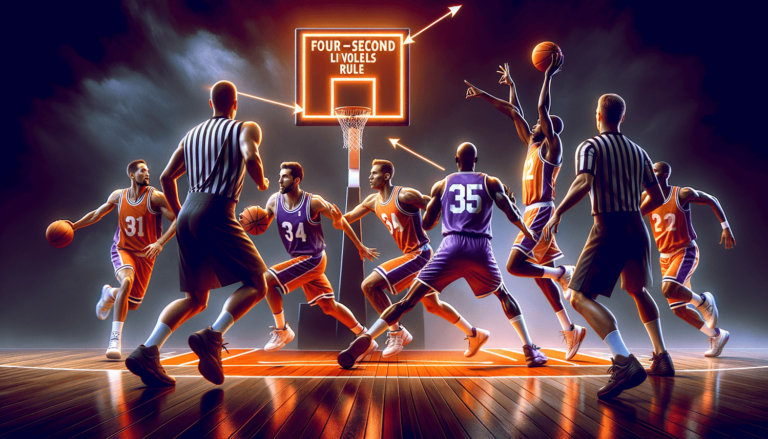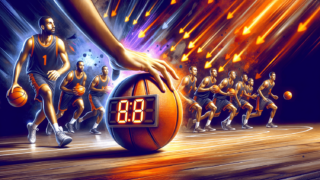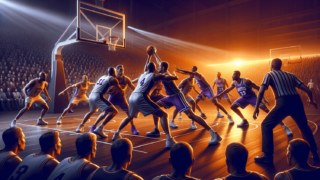
Four-Second Lane Violation Rule in Basketball
Written by: Basketball Universe
Last updated:

Welcome to the captivating world of basketball! The game we know and love is built on fast-paced action, teamwork, and an intricate web of rules that ensure fair play. Today, we’re diving into one specific rule – the Four-Second Lane Violation. This might not be as flashy as dunks, crossovers, or buzzer-beaters, but rest assured, understanding it will vastly enhance your appreciation and knowledge of the game. So, buckle up and read on as we delve into the nuances of this essential regulation that tests both offense and defense and maintains basketball’s fluidity and zeal.
Four-Second Lane Violation Rule in Basketball
The Four-Second Lane Violation Rule, commonly referred to as the three-second rule, is a basketball regulation that prohibits offensive players from remaining in the lane or the key area for more than three consecutive seconds without actively attempting to score or if they don’t have the ball. This rule encourages the offense to keep the game dynamic and prevents stalling around the basket, while simultaneously providing the defense a fair opportunity to contest shots or rebounds. A violation results in a turnover, with the opposing team gaining possession of the ball.
A Brief History of the Four-Second Lane Violation Rule
Before we delve into the intricacies of the four-second lane violation rule, let’s turn back the clock and explore its origins. Established in the 1936, the rule was initially aimed at curbing the dominance of talented big men in the paint – the area close to the basket. The initial three-second rule was the result. Interestingly, the premise of this regulation was simple: make the game more dynamic and free-flowing by discouraging players from camping out around the basket for extended periods. Over time, the basketball rules evolved, and the four-second lane violation rule now applies to offensive players without the ball.
Understanding the Four-Second Lane Violation Rule
What is the Four-Second Lane Violation Rule?
The Four-Second Lane Violation Rule, often called the three-second rule, is a basketball regulation that prevents offensive players from spending more than four consecutive seconds within the lane or the key area without actively attempting to score or if they don’t have the ball. This rule strikes a delicate balance between maintaining fluidity and promoting fair play. When violated, the penalizing team suffers a turnover, forfeiting possession to the other team.
Defining the Lane or Key Area
The key area, or simply “the key,” refers to the painted area on the court that extends from the baseline to the free-throw line, with its width encompassing the distance between the two parallel lines on either side of the restricted area. It is named after the shape it resembles – an old-fashioned keyhole. Both offensive and defensive players jockey for position in the key during gameplay, as it is a critical area for scoring and rebounding.
The Importance of the Four-Second Lane Violation Rule
Keeping the Game Dynamic
One of the primary objectives of the four-second lane violation rule is to bolster the fast-paced nature of basketball. By limiting the time offensive players can spend within the key without scoring or possessing the ball, the rule encourages continuous motion and more diverse offensive strategies. This rule not only mitigates stagnant play but also heightens spectators’ excitement as the action unfolds on the court.
Promoting Fair Play
In addition to fostering a dynamic game, the four-second lane violation rule levels the playing field by preventing offenses from exploiting the low-post advantage that taller or bulkier players typically enjoy near the basket. By enforcing time restrictions in the key area, the rule demands that offensive players act efficiently and skillfully, ensuring respectful competition.
Tactics and Strategies Affected by the Four-Second Lane Violation Rule
Spacing and Off-The-Ball Movement
A critical element of modern basketball strategy, spacing requires players to distribute themselves evenly across the court, opening lanes for drives or allowing for easier perimeter passes. By enforcing the four-second rule, coaches and players must design offensive plays that account for the time limit, making it integral to factor in off-the-ball movement and effective passing. Consequently, this regulation plays a vital role in the formulation of cohesive offensive tactics, enhancing the sport in a profound way.
Offensive Rebounding
Offensive rebounding occurs when a player recovers a missed shot from their team, which often results in a second-chance opportunity for scoring. Due to the four-second lane violation rule, offensive players are mindful of their time spent in the key area, moving in and out strategically to maximize rebounding opportunities without flouting the regulation. Thus, the rule has indirect consequences for offensive rebounding schemes and challenges coaches to devise appropriate gameplans.
Post Play
Post play, comprising inside scoring and moves around the painted area, is a staple aspect of basketball. However, it can be potentially impacted by the four-second lane violation rule if post players fail to make their move in a timely fashion. This rule forces players to operate cleverly and proficiently in the low post, prompting the development of more versatile and agile big men in the sport.
Recognizing and Adapting to the Four-Second Lane Violation Rule
Offensive Awareness
Both experienced players and newcomers must develop keen awareness regarding their time spent in the key area. To successfully adapt to the four-second lane violation rule, offensive players should cultivate court-savvy instincts, maintaining positional cognizance and obeying the time restriction. Improved court knowledge, well-practiced offensive moves, and effective off-the-ball court navigation yield significant benefits for players looking to maximize their performance.
Defensive Opportunities
On the other end of the spectrum, defensive players can exploit the four-second lane violation rule to their advantage. By recognizing opponents’ positioning in the lane, defenders can apply pressure on offensive players, forcing them to leave the restricted area or risk a violation. Consequently, savvy defenders harness the rule to delay or prevent advantageous scoring opportunities for their opponents.
Notable Exceptions to the Four-Second Lane Violation Rule
Offensive Player with the Ball
The four-second lane violation rule does not apply if the offensive player has control of the ball. This exception promotes and rewards assertive play, allowing players to exhibit their skillset without the hindrance of the four-second rule.
Free Throw Situations
During free throw attempts, the four-second lane violation rule is momentarily suspended. As the offensive player at the free-throw line prepares to take the shot, players who have taken their positions along the key are exempt from the rule. Nevertheless, once the ball is live again following the free throw, the rule resumes its standard function.
Active Scoring Attempt
An offensive player working towards a viable scoring attempt is excused from the four-second lane violation rule. The rule acknowledges that the player’s primary aim is to put points on the board, thereby making an exception in such situations. Furthermore, any doubts regarding the validity of a scoring attempt are typically resolved in favor of the offensive player, emphasizing the importance of proactive engagement in the sport.
In conclusion, the four-second lane violation rule is fundamental to the game of basketball. Its impact on strategy, tactics, and fair play is substantial, rendering it an indispensable component of the sport. By enhancing player awareness and cultivating familiarity with this rule, you will deepen your appreciation for the exciting and nuanced world of basketball.
Frequently Asked Questions about the Four-Second Lane Violation Rule
What is the penalty for a four-second lane violation?
When an offensive player commits a four-second lane violation, the penalty is a turnover. The opposing team is awarded possession of the ball, and the violating team loses an opportunity to score on that play.
How do officials keep track of the four-second time limit?
Referees use their experience, training, and sometimes an internal count to gauge the time an offensive player spends in the key area. While this may not be scientifically exact, they consistently apply their judgment to enforce the four-second lane violation rule fairly and effectively.
Does the four-second lane violation rule apply to both collegiate and professional levels of play?
Yes, the four-second lane violation rule, commonly known as the three-second rule, is applicable in both collegiate and professional basketball leagues such as the NCAA, NBA, and FIBA. However, the dimensions of the key area may differ slightly between different organized basketball rulebooks, so it is essential to understand the specific rules of each league or level to ensure compliance.
What is the relationship between the four-second lane violation rule and the defensive three-second rule?
The four-second lane violation rule pertains to offensive players, while the defensive three-second rule governs defensive players. The defensive three-second rule stipulates that defenders who are not actively guarding a player must not remain in the key area for more than three consecutive seconds. Though these rules target different types of players, both serve to maintain the dynamic and competitive nature of basketball by ensuring proper positioning on the court.
Further Tips and Tricks to Avoid Four-Second Lane Violation
Establish a Mental Count
Developing a mental count while on the court can be immensely helpful for offensive players. By incrementally counting while inside the key area, players can gauge their time spent in the restricted zone, fostering heightened awareness of the four-second lane violation rule as they participate in each play.
Recognize Cues from Teammates
Teammate communication is vital for avoiding lane violations. Engaging in verbal or nonverbal cues alongside well-rehearsed offensive plays can help players quickly identify and react to potential four-second lane violations, minimizing turnovers and maximizing scoring opportunities.
Effective Passing and Screening
Integrating efficient passing and screening techniques into your team’s offensive strategy can contribute to a better understanding of the four-second lane violation rule. By rotating the ball among teammates and consistently implementing screens, offensive players can organically evade violations while distracting their opponents and attacking the basket effectively.
Study and Learn from Top Players
By studying the game of basketball and observing the strategies employed by professional players, fans can develop a better understanding of the four-second lane violation rule. Closely analyzing the movement of skilled big men, point guards, and wings, in particular, can reveal a trove of useful tips and invaluable insights for effectively navigating the restrictions imposed by the rule.
Frequently Asked Questions about the Four-Second Lane Violation Rule
As basketball enthusiasts, we know that you may have plenty of questions about the four-second lane violation rule. Here is a FAQ section that addresses common questions and offers quick answers to deepen your understanding of this essential basketball regulation.
1. What is the purpose of the four-second lane violation rule?
The rule aims to maintain basketball’s dynamic and fast-paced nature by restricting the time offensive players can spend within the key area without actively attempting to score or not having the ball.
2. How does the four-second lane violation rule affect playing strategy?
Players must adapt their off-the-ball movements, spacing, and post-play strategies to comply with the four-second rule, making the game more dynamic and less focused on simply camping near the basket.
3. How do referees enforce the four-second lane violation rule?
Officials use visual cues and internal counts to monitor the time offensive players spend in the key area, enforcing the rule based on their experience and judgment.
4. Can defensive players also be penalized for spending too much time in the key?
Yes, the defensive three-second rule prohibits defenders who are not actively guarding a player from staying in the key area for more than three consecutive seconds.
5. Are there any exceptions to the four-second lane violation rule?
Exceptions apply when an offensive player has control of the ball, during free throw attempts, or when a player is actively attempting to score.
6. What are the consequences of a four-second lane violation?
The violating team suffers a turnover, forfeiting possession to the opposing team and losing an opportunity to score on that particular play.
7. Why is the rule sometimes referred to as the three-second rule?
The name discrepancy is due to the common overlapping use of the terms “four-second” and “three-second” for the same rule. The rule historically referred to as the three-second rule has evolved over time and is now often called the four-second lane violation rule.
8. Does the four-second rule apply in both college and professional basketball?
Yes, the four-second lane violation rule is applicable in both collegiate and professional basketball leagues, such as the NCAA, NBA, and FIBA. However, the dimensions of the key area may differ slightly between leagues.
9. Does the rule work differently in international play?
The concept is generally the same across different leagues, including international play, but specific dimensions and implementations of the rule may vary. Always consult the rulebook for the specific league or competition in question.
10. How can players develop better awareness of the four-second lane violation rule?
Players can hone their awareness through improved court knowledge, well-practiced offensive moves, effective off-the-ball court navigation, and quick mental timekeeping while on the court.
Featured Posts
- No pillar pages found.





